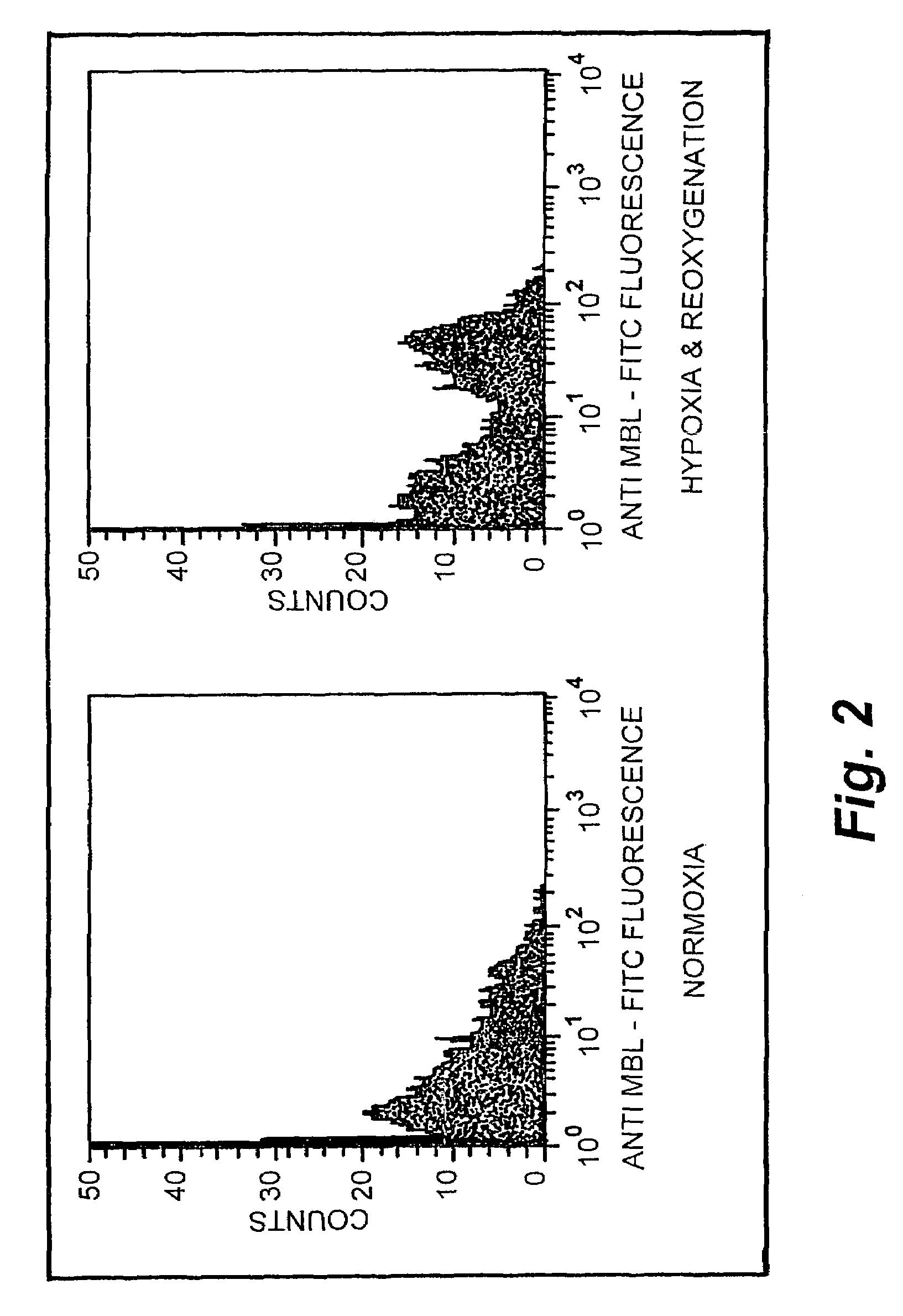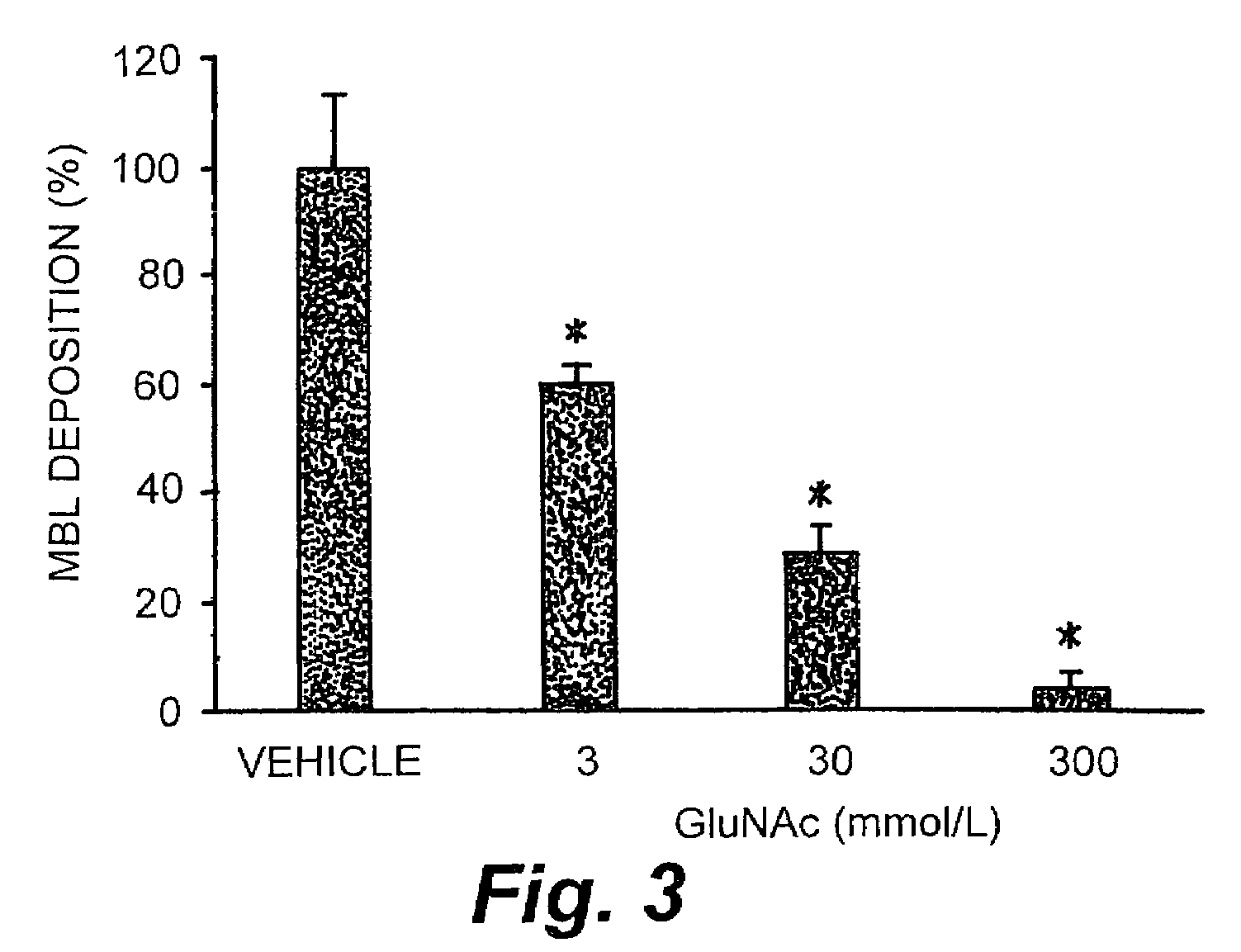Methods and products for regulating lectin complement pathway associated complement activation
a technology of lectin complement and pathway, applied in the direction of fused cells, antibody medical ingredients, drug compositions, etc., can solve problems such as medical disorders, and achieve the effects of inhibiting lcp-associated complement activation, inhibiting cellular mbl deposition and lcp-associated complement activation, and inhibiting cellular injury
- Summary
- Abstract
- Description
- Claims
- Application Information
AI Technical Summary
Benefits of technology
Problems solved by technology
Method used
Image
Examples
example 1
MBL and Complement Deposition on Human Coronary Arteries
[0118]Isolation and Purification of MBL. MBL and associated MASPs were purified from human plasma. MBL was isolated from human plasma as previously described{Tan, Chung, et al. 1996 Biochem. J. 319, 329-332}. Briefly, human plasma was mixed with 7% PEG3500 (w:v). The pellet was collected by centrifugation and resuspended in TBS-Ca2+ [50 mM Tris, 150 mM NaCl, 0.05% Tween 20 and 20 mM CaCl2 at pH 7.8]. The supernatant was applied to a mannan-Sepharose column (25 ml, Sigma). The column was washed with TBS-Ca2+ with 109 mM EDTA]. The protein containing supernatant was calcified to 40 mM calcium and then applied to a maltose-Sepharose column (5 ml). The column was washed with TBS-Ca2+ and then eluted with TBS-Ca2+ containing 100 mM N-acetylglucosamine. Western analysis and SDS-PAGE established purity for MBL, and the absence of IgG and IgM. Purified MBL and associated MASPs were analyzed by SDS / PAGE. Western blotting was performed t...
example 2
Endothelial Hypokia / Reoxygenation Effects MBL Deposition
[0123]Cell Culture. Human umbilical vein endothelial cells (HUVECs) were harvested with 0.1% collagenase (Worthington Biochemical Corp., Freehold, N.J.) and suspended in Media 199 containing 20% heat-inactivated bovine calf serum (Gibco Life Technologies Inc., Grand Island, N.Y.). The cells were initially seeded in either 75 cm2 flasks or 100 mm Petri dishes (Corning Costar, Cambridge, Mass.), and incubated at 37° C. in 95% air and 5% CO2. When confluent, the endothelial cells were passaged with 0.5% trypsin-EDTA. Endothelial cell purity was assessed by phase microscopic “cobblestone appearance”, uptake of fluorescent acetylated low-density lipoprotein and the presence of von Willebrand factor. All experiments were conducted on HUVECs during passages 1-3.
[0124]MBL-depleted Human Serum (HS). HS was depleted of MBL by affinity chromatography using mannan cross-linked to 4% beaded agarose (Sigma Chemical Co., St. Louis, Mo.). All ...
example 3
Deposition of iC3b Following Competitive Inhibition of MBL
[0129]HUVEC cell culture and quantitation of iC3b deposition by ELISA were performed as outlined in Example 2.
[0130]Results. HUVECs were subjected to 0 or 24 hr of hypoxia followed by 3 hr of reoxygenation in the presence of 30% HS or 30% HS treated with 3, 30, or 300 mmol / L GluNAc, D-mannose or L-mannose in order to inhibit MBL deposition, LCP activation and iC3b deposition. Deposition of iC3b on hypoxic HUVECs reoxygenated in 30% HS or 30% HS treated with L-mannose was significantly greater (approximately 3-fold; OD405=0.14±0.01; p405=0.05±0.01) or hypoxic HUVECs reoxygenated in HS treated with GluNAc or D-mannose (FIG. 4a). Further, D-mannose, but not L-mannose, inhibited iC3b deposition on hypoxic / reoxygenated HUVECs in dose-dependent manner with 3, 30 and 300 mmol / L of D-mannose attenuating iC3b deposition 19±2%, 52±3% and 96±2%, respectively. Thus, these data demonstrated that inhibition of MBL deposition using GluNAc o...
PUM
 Login to View More
Login to View More Abstract
Description
Claims
Application Information
 Login to View More
Login to View More - R&D
- Intellectual Property
- Life Sciences
- Materials
- Tech Scout
- Unparalleled Data Quality
- Higher Quality Content
- 60% Fewer Hallucinations
Browse by: Latest US Patents, China's latest patents, Technical Efficacy Thesaurus, Application Domain, Technology Topic, Popular Technical Reports.
© 2025 PatSnap. All rights reserved.Legal|Privacy policy|Modern Slavery Act Transparency Statement|Sitemap|About US| Contact US: help@patsnap.com



